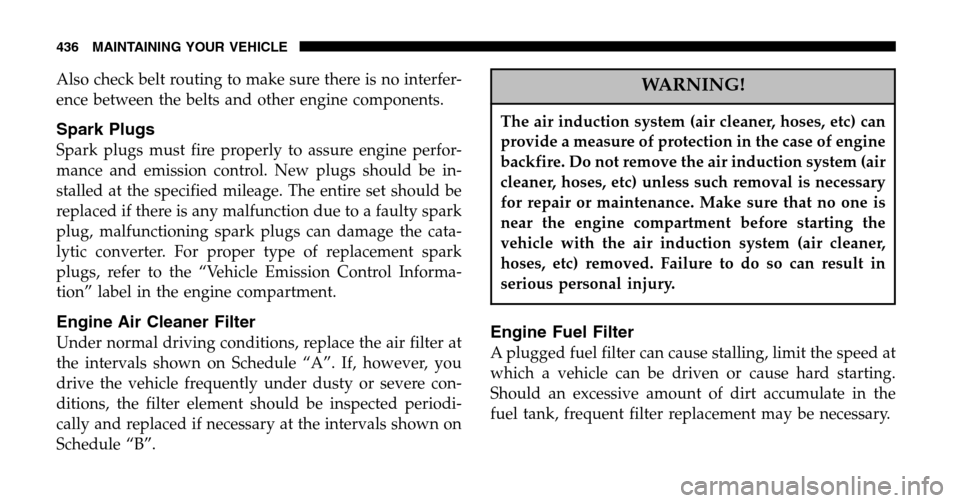Page 386 of 536

NOTE:During snowplow usage on vehicles equipped
with an overhead console module, the outside tempera-
ture display will show higher temperatures than the
outside ambient temperature. The higher displayed tem-
perature is due to blocked or reduced airflow to the
underhood ambient temperature sensor by the snow-
plow. This is common and outside temperature display
operation will return to normal when the snowplow is
removed.
General Maintenance
Snowplows should be maintained in accordance with the
plow manufacturer’s instructions. Whenever the plow is
disconnected from the vehicle, coat the exposed angling
cylinder rods with chassis lubricant. The lift cylinder
should be extended upward and chassis lubricant ap-
plied to the lift rod. The hydraulic hoses interconnect to
keep the couplers clean. Keep all snowplow electrical connections and battery
terminals clean and free of corrosion.
When plowing snow, to avoid transmission and driv-
etrain damage, the following precautions should be ob-
served.
•Operate with transfer case in 4L when plowing small
or congested areas where speeds are not likely to
exceed 15 mph (24 km/h). At higher speeds operate in
4H.
•Do not shift the transmission unless the engine has
returned to idle and wheels have stopped. Make a
practice of stepping on the brake pedal before shifting
the transmission between forward and reverse.
NOTE: Change the automatic transmission fluid and
filter(s) according to Maintenance Schedule �B.�
386 STARTING AND OPERATING
Page 423 of 536
MAINTAINING YOUR VEHICLE
CONTENTS
�Engine Compartment— 3.7L/4.7L ...........426
� Engine Compartment— 5.7L ...............427
� Onboard Diagnostic System (OBD II) .........428
� Emissions Inspection And Maintenance
Programs ............................428
� Dealer Service .........................430
� Replacement Parts ......................431
� Maintenance Procedures ..................431
▫ Engine Oil ..........................431 ▫
Engine Oil Filter ......................435
▫ Drive Belts — Check Condition And
Tensioner ...........................435
▫ Spark Plugs .........................436
▫ Engine Air Cleaner Filter ................436
▫ Engine Fuel Filter .....................436
▫ Catalytic Converter ....................437
▫ Emission-Related Components ............439
▫ Maintenance Free Battery ................439
7
Page 435 of 536

the engine oil. Engine oil is an engineered product and
it’s performance may be impaired by supplemental ad-
ditives.
Disposing of Used Engine Oil And Oil Filters
Care should be taken in disposing of used engine oil and
oil filters from your vehicle. Used oil and oil filters,
indiscriminately discarded, can present a problem to the
environment. Contact your dealer, service station, or
governmental agency for advice on how and where used
oil and oil filters can be safely discarded in your area.
Engine Oil Filter
The engine oil filter should be replaced at every engine
oil change.
Engine Oil Filter Selection
The manufacturer’s engines have a full-flow type oil
filter. Use a filter of this type for replacement. The quality
of replacement filters varies considerably. Only high quality filters should be used to assure most efficient
service. Mopar Engine Oil Filters are a high quality oil
filter and are recommended.
Drive Belts — Check Condition and Tensioner
Belt tension is controlled by means of an automatic
tensioner. No belt tension adjustments are required.
However, belt and belt tensioner condition should be
inspected at the specified intervals and replaced if re-
quired. See your authorized dealer for service.
At the mileage indicated in the maintenance schedule, all
belts and tensioner should be checked for condition.
Improper belt tension can cause belt slippage and failure.
Belts should be inspected for evidence of cuts, cracks,
glazing or frayed cords and replaced if there is indication
of damage which could result in belt failure. Low gen-
erator belt tension can cause battery failure.
MAINTAINING YOUR VEHICLE 435
7
Page 436 of 536

Also check belt routing to make sure there is no interfer-
ence between the belts and other engine components.
Spark Plugs
Spark plugs must fire properly to assure engine perfor-
mance and emission control. New plugs should be in-
stalled at the specified mileage. The entire set should be
replaced if there is any malfunction due to a faulty spark
plug, malfunctioning spark plugs can damage the cata-
lytic converter. For proper type of replacement spark
plugs, refer to the “Vehicle Emission Control Informa-
tion” label in the engine compartment.
Engine Air Cleaner Filter
Under normal driving conditions, replace the air filter at
the intervals shown on Schedule “A”. If, however, you
drive the vehicle frequently under dusty or severe con-
ditions, the filter element should be inspected periodi-
cally and replaced if necessary at the intervals shown on
Schedule “B”.
WARNING!
The air induction system (air cleaner, hoses, etc) can
provide a measure of protection in the case of engine
backfire. Do not remove the air induction system (air
cleaner, hoses, etc) unless such removal is necessary
for repair or maintenance. Make sure that no one is
near the engine compartment before starting the
vehicle with the air induction system (air cleaner,
hoses, etc) removed. Failure to do so can result in
serious personal injury.
Engine Fuel Filter
A plugged fuel filter can cause stalling, limit the speed at
which a vehicle can be driven or cause hard starting.
Should an excessive amount of dirt accumulate in the
fuel tank, frequent filter replacement may be necessary.
436 MAINTAINING YOUR VEHICLE
Page 459 of 536

should be performed anytime a malfunction is observed
or suspected. Proper maintenance of the entire vehicle
will help the effectiveness of the noise control systems.
Air Cleaner Assembly
Inspect air cleaner housing for proper assembly and fit.
Make certain that the air cleaner is properly positioned
and the cover is tight. Check all hoses leading to the
cleaner for tightness. The gasket between the air cleaner
housing and throttle body must be intact and in good
condition. The engine air cleaner filter must also be clean
and serviced according to the instructions outlined in the
appropriate maintenance schedule.
Tampering with Noise Control System Prohibited
Federal law prohibits the following acts or the causing
thereof: (1) the removal or rendering inoperative by any
person, other than for purposes of maintenance, repair, or
replacement, of any device or element of design incorpo-
rated into any new vehicle for the purpose of noise control prior to its sale or delivery to the ultimate
purchaser or while it is in use, or (2) the use of the vehicle
after such device or element of design has been removed
or rendered inoperative by any person.
Among those acts presumed to constitute tampering are
the acts listed below.
AIR CLEANER
•Removal of the air cleaner.
•Inverting the air cleaner lid.
•Removal of the air ducting.
EXHAUST SYSTEM
•Removal or rendering inoperative exhaust system
components including the muffler or tailpipe.
MAINTAINING YOUR VEHICLE 459
7
Page 492 of 536
Miles 3,000 6,000 9,000 12,000 15,000
(Kilometers) (5 000) (10 000) (15 000) (20 000) (25 000)
Change engine oil and engine oil filter at interval
shown or 3 months, whichever comes first. X X XXX
Lubricate Front Drive Shaft Fitting (2500/3500,
4X4). X X XXX
Rotate tires. X X
Check spare tire for proper pressure and correct
stowage. XX
Lubricate outer tie rod ends 2500/3500 (4X4) mod-
els only. XX
Change rear axle fluid. X
Change front axle fluid (4X4). X
Inspect brake linings. X
Inspect engine air cleaner filter, replace if neces-
sary. X
492 SCHEDULE “B”
8
M
A I
N T
E
N A
N C E
S
C
H E
D
U L
E
S
Page 493 of 536
Miles 18,000 21,000 24,000 27,000 30,000
(Kilometers) (30 000) (35 000) (40 000) (45 000) (50 000)
Change engine oil and engine oil filter at interval shown or
3 months, whichever comes first. XXXXX
Lubricate Front Drive Shaft Fitting (2500/3500, 4X4). X X X X X
Rotate tires. X X X
Check spare tire for proper pressure and correct stowage. X X X
Lubricate outer tie rod ends 2500/3500 (4X4) models only. X X X
Change rear axle fluid. X
Change front axle fluid (4X4). X
Check transfer case fluid level (4X4). X
Inspect brake linings. X
Inspect engine air cleaner filter, replace if necessary. X
Replace spark plugs. X
Inspect PCV valve, replace as necessary. ** X
SCHEDULE “B” 493
8
M
A I
N T
E
N A
N C E
S
C
H E
D
U L
E
S
Page 494 of 536
Miles 33,000 36,000 39,000 42,000 45,000
(Kilometers) (55 000) (60 000) (65 000) (70 000) (75 000)
Change engine oil and engine oil filter at interval
shown or 3 months, whichever comes first. X X XXX
Lubricate Front Drive Shaft Fitting (2500/3500,
4X4). X X XXX
Rotate tires. X X
Check spare tire for proper pressure and correct
stowage. XX
Lubricate outer tie rod ends 2500/3500 (4X4) mod-
els only. XX
Change rear axle fluid. X
Change front axle fluid (4X4). X
Inspect brake linings. X
Inspect engine air cleaner filter, replace if neces-
sary. X
494 SCHEDULE “B”
8
M
A I
N T
E
N A
N C E
S
C
H E
D
U L
E
S